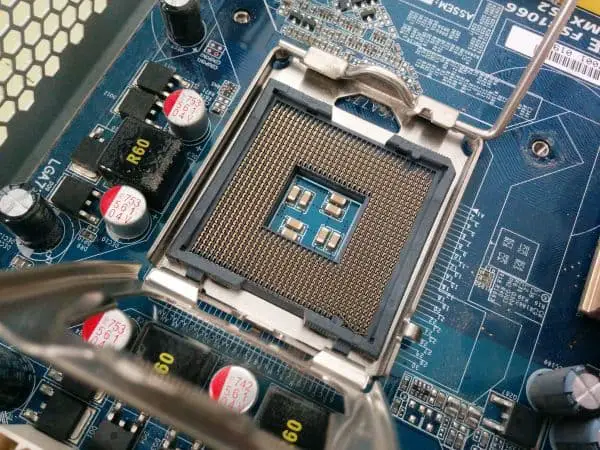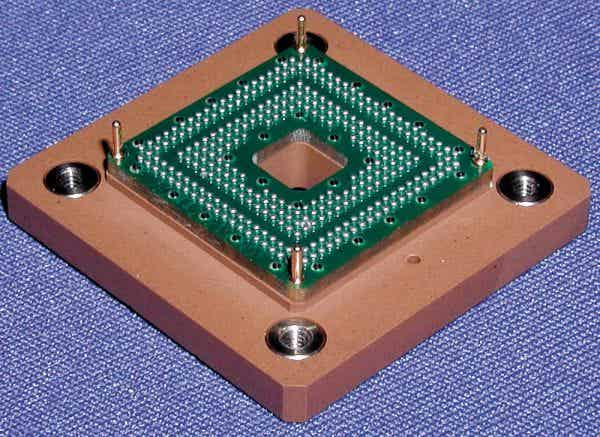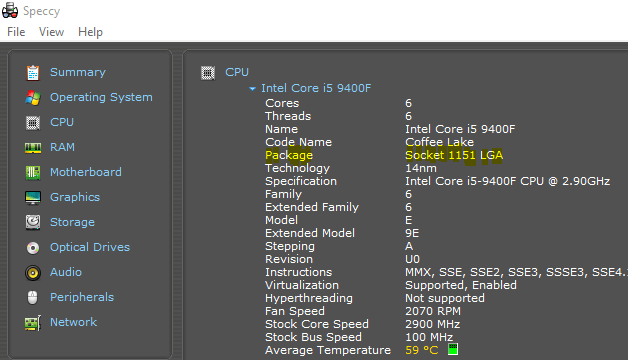CPU Sockets Types [LGA, PGA, ZIF, BGA], Intel vs AMD Sockets
There are different CPU sockets types available for PC motherboards; despite that, why should you care about processor sockets. Well, if you want to upgrade your processing chip, you need to know the types of CPU sockets.
The socket type of your motherboard determines what kind of processor you can use, whether it is worth upgrading your processor, or upgrading your entire system. Even if you have to assemble a new computer, you need to know that the socket, in such a case, is one of the basic concepts.
Socket types must be differentiated, with the variety of sockets that we see between Intel and AMD, both on desktop and laptops.
There are not many types, but it is useful to see the different types of CPU sockets, their dimensions, and the compatibilities they offered. In this article, let’s know different CPU socket types and the specifics of their use in a PC, and the processors that are fit with them.
CPU Socket – What is it?
A socket is a place on the motherboard plate of the computer where the processor is inserted. It acts as a connector to connect and provide mechanical and electrical connections between the central processing unit (CPU) to the motherboard.
As we how motherboard is important for determine chip compatibility for CPU sockets either in desktops or servers. But in a case of laptops, they generally use surface-mounted processors instead of socket processors to save space on the motherboard and reduce its overall physical size.
The processor, before it is installed in the motherboard, must match its socket. So the processor socket is almost the most important characteristic. It is this that you should pay attention to when buying a new processor because it may happen that the processor does not fit the computer’s motherboard precisely because of the socket.
Sockets differ in the number of pins, which usually grows with the power and complexity of the processors. Some of the pins are used to power the processor, and some are in use for the operation of the processor itself, PCI Express bus, RAM, etc. For each socket, there is a unique pinout, and it looks something like this:
On the other hand, some CPU socket types have several holes known as great matrix, whose sizes and shapes can vary depending on the pins that are going to be inserted and each port having a specific function. Through this matrix, it is possible to maintain a connection with the microprocessor where all the equipment works simultaneously.
4 Types of CPU Sockets
There is a wide variety of sockets where each one is used in different types of microcomputers. They have different pins and have differences in terms of the interconnection made and their geometric arrangement.
Depending on the physical arrangement of the socket components, there are mainly four types of computer processor sockets:
1. LGA Sockets
The LGA (Land Grid Array) is a socket whose assembly is in packaging for integrated circuits. In these types of sockets, the needles are located in the CPU socket, and there are metallic points of contact in the lower area of the processor. The LGA can be electrically connected to a motherboard through a connector or by soldering the board directly.

Since the socket has the pins on the motherboard instead of on the microprocessor, the microprocessor contains holes in its lower part where they insert; this prevents the microprocessor pins from being damaged, and it is the most current of all sockets.
Many Intel sockets have seen LGA types, such as the LGA 1150, LGA 1155, or LGA 1200. AMD has also used this type of socket since the powerful “Opteron” chips in the early 2000s.
Going to more advanced dates, the TR4 or sTRX4 (Threadripper) socket is the first “consumer” LGA introduced by AMD (LGA 4094). Instead, Intel uses LGA for all processor ranges: servers, desktops, etc.
LGA plugs apply a compressive force after attaching a faceplate. Therefore, it can provide superior mechanical retention while avoiding the risk of bending the pins when installing the processor in the socket.
Also, the LGA sockets are much more profitable and better than some of the previous ones, and that is that they have the great advantage of allowing a larger and safer power source for the processor than the others.
2. PGA Sockets
The PGA (Pin Grid Array) is an integrated circuit packaging identified by being rectangular or square, whose pins are aligned in a regular matrix. Here, the pins may not cover the entire surface but leave gaps between them, with the standard spacing of 2.54mm.

It is designed to contain processors with a set of pointing pins. A PGA grip applies a compressive force once the handle is in place. This allows for better mechanical retention and avoids the risk of bending the pins when inserting the processor into the socket.
It falls within the oldest types of CPU sockets in computing, although they are not the most senior. Their configuration allows more pins per circuit than DIP sockets, which are much older. The big problem with the PGAs was that if a pin broke, it becomes worthless.
Examples of processors that have used PGA, like the legendary Intel 80386 or 80486, used this socket.
To say that we have seen variables of this socket, mainly PPGA (Plastic Pin Grid Array) and FCPGA (Flip-Chip Pin Grid Array), created by Intel for Pentium processors. Also, we saw the CPGA or OPGA, but they are much less known.
This configuration allows the motherboard socket to be stronger because the pins go into the processor. It is the typical AMD socket, from Athlon’s socket A to Ryzen’s AM4.
LGA vs PGA Sockets
LGA and PGA sockets can be perceived as opposites. A “Land Grid Array” (LGA) comprises of a socket with pins on which you install the CPU chip. The PGA (“Pin Grid Array”), in contrast, places the pins on the processor chip, which is then embedded into a socket with fittingly spaced holes.
In the present day computing era, Intel processors use mostly LGA sockets type, and AMD processors use PGA sockets. However, there are major exceptions to this lead.
For example, the monstrous AMD Threadripper (has Simultaneous Multi-Threading tech) uses Socket TR4 (Threadripper 4) is a LGA socket. Previously, with Intel processors such as the Pentium, Pentium 2, and Pentium 3 were PGA sockets.
LGA sockets have important advantages over older PGA sockets:
- Cheaper production of the processor,
- Less leakage current,
- The ability to manufacture very large sockets like Intel’s LGA 3647 or AMD’s TR4,
- Very reliable CPU retention compared to PGA sockets.
But PGA sockets also have their advantages:
- The socket itself is cheaper, which makes the motherboard more affordable,
- The feet on the processor are more reliable than the feet on the LGA socket and allow for the repair of dented feet. It is very easy to get damage of the legs in the LGA socket, also it is so difficult to straighten,
- PGA socket is more compact and more suitable for mobile technology.
3. ZIF sockets
ZIF (Zero Insertion Force): This is an evolution of the PGA, where the pins are carried by the microprocessor and inserted into the socket connectors. This mechanism is defined by not exerting any pressure (Zero Insertion Force) when installing or removing the processor from the socket.

But rather uses a lever that acts as a safety device, the lever next to the socket allows it to be inserted without force, preventing the pins from bending and blocking it so that it does not come off even if the heatsink is not installed.
For CPU chips with many pins, the ZIF type of CPU sockets is preferred. To install a processor in a ZIP CPU socket, simply remove the chip. Once the chip is in place, turn a lever to lock the CPU in place. To remove the processor, turn the lever in the other direction and lift the chip.
ZIF sockets are widely used in memories or any computer component that allows the modification of informative data.
AMD is the one who has used the ZIF socket for its 939, AM2, 757, 940, M2 or S1 sockets. This is ideal to avoid damaging the processor’s pins when we manage it. The AM4 socket is also ZIF because it comes with its lever.
We also saw the LIF (Low Insertion Force). This mechanism lacked a lever and was a technology used in integrated circuit sockets designed to exert (little) force when inserting or removing the processor. Ultimately, they dropped to the ZIFs because they were safer.
4. BGA Sockets
Not as famous as other types of sockets, the BGA (Ball Grid Array) socket is not technically a socket because its main characteristic is that the microprocessors are permanently mounted in this socket.

In this case, instead of pins, some copper balls are soldered directly to the motherboard. Eliminate any possibility of upgrading or replacing the microprocessor.
The BGA connector and motherboard could cost less, but there are very few equivalents between consumer BGA and LGA and PGA products. So, where do you find this socket? Well, in laptops, mobiles, memory chips, or any other small electronic board.
However, with the increase in system-on-a-chip (Intel) hardware, Intel has expanded the use of its BGA socket. Likewise, ARM, Broadcom, Qualcomm, Nvidia, and other SoC manufacturers rely heavily on BGAs.
Some devices use BGA-type sockets, which require the CPU processors to be soldered into their bay. Therefore, this type of CPU socket does not allow the CPU to be replaced after one has been installed.
Why are there different processor sockets?
Different types of CPU sockets are a result of the continuous development of computer technology. Each of the connectors replaces the previous one when it cannot provide the normal operation of new processors for some parameters.
At the physical level, all sockets differ in size and shape, processor architecture, number of contacts, type, and location. In addition, they differ in the mounting of the processor cooling system. These often new requirements make different kinds of sockets incompatible with each other.
A processor using a specific socket type isn’t necessary to fit any motherboard with that socket. Thus, only a processor designed specifically for it can connect to a certain type of socket. You cannot remove the processor from the computer and replace it with any other. Only a processor with the same socket will operate.
Likewise, there are two main manufacturers of x86 processors: AMD and Intel. Both AMD and Intel processors have separate processor architectures, and most of the time, no compatibility is possible between them.
Intel vs AMD CPU Sockets
CPU Sockets are located near the VRM section of the motherboard for modern Intel processors in which the pins are located in the socket itself (in the image below on the right), and for AMD processors, they are slotted, when the pins are soldered to the processor, and the slot has slots into which these pins are inserted.

1. Intel CPU Sockets
There are several types of sockets that INTEL has used from its origins, some of them are:
2. AMD CPU Sockets
Concerning AMD, several types of sockets have been used that has even existed since its origins, such as:
As in the previous case, the last two sockets in the list are still the most relevant at the moment.
How to find out which Socket type does my computer has?
To determine which socket is on your motherboard, it is just to remove the processor cooler and clear the CPU from thermal paste; the processor itself will say which socket it has so that the motherboard will have the same socket. Well, it may be not possible for everyone.
So, you can use free software called Speccy weighs a couple of megabytes, which detects a socket type on your computer. As you can see below’s image, it identified the ‘Socket 1151 LGA’.

Also, if you are only going to purchase or have already purchased a processor. In that case, the socket marking will also be written on the box itself or in the documentation for the processor. For the motherboard, manufacturers indicate the socket directly on the packaging box, in rather large letters.
Which socket should you choose?
As a rule, no one chooses the Socket itself when assembling a computer. The Socket affects which CPU cooler you will need to buy to fit the motherboard the way the Socket also selects it.
The choice of Socket can only fall if you want to upgrade the processor in the future, but this option will suit you if you intend to buy an AMD processor. But if you’re going to use an Intel processor, then you do not have to choose a socket as with the release of a new processor, the socket version changes, and the motherboard will need to be replaced.
Pro Tip: Select the desired processor first and then look for a motherboard and cooler with the same socket.
Conclusion
In this article, I told you what a socket is, what it is intended for, types of CPU sockets and how to get information about the type of interface on your PC. In short, in PC, the most famous is the PGA and LGA, leaving the BGA for laptops or small devices.
However, sockets have come a long way in 40 years, constantly changing and increasing contacts by 30 times. Some sockets types remain valid for a very short time and are not very popular, and some become long-livers.
And in final words – A small recommendation for those who will buy a new processor: before buying, always check the compatibility of the motherboard socket and the processor. For knowing the compatibility you can check out the guide in the next article.
This ends our article ‘CPU Socket Types‘ Share this insightful article on social networks as well.
